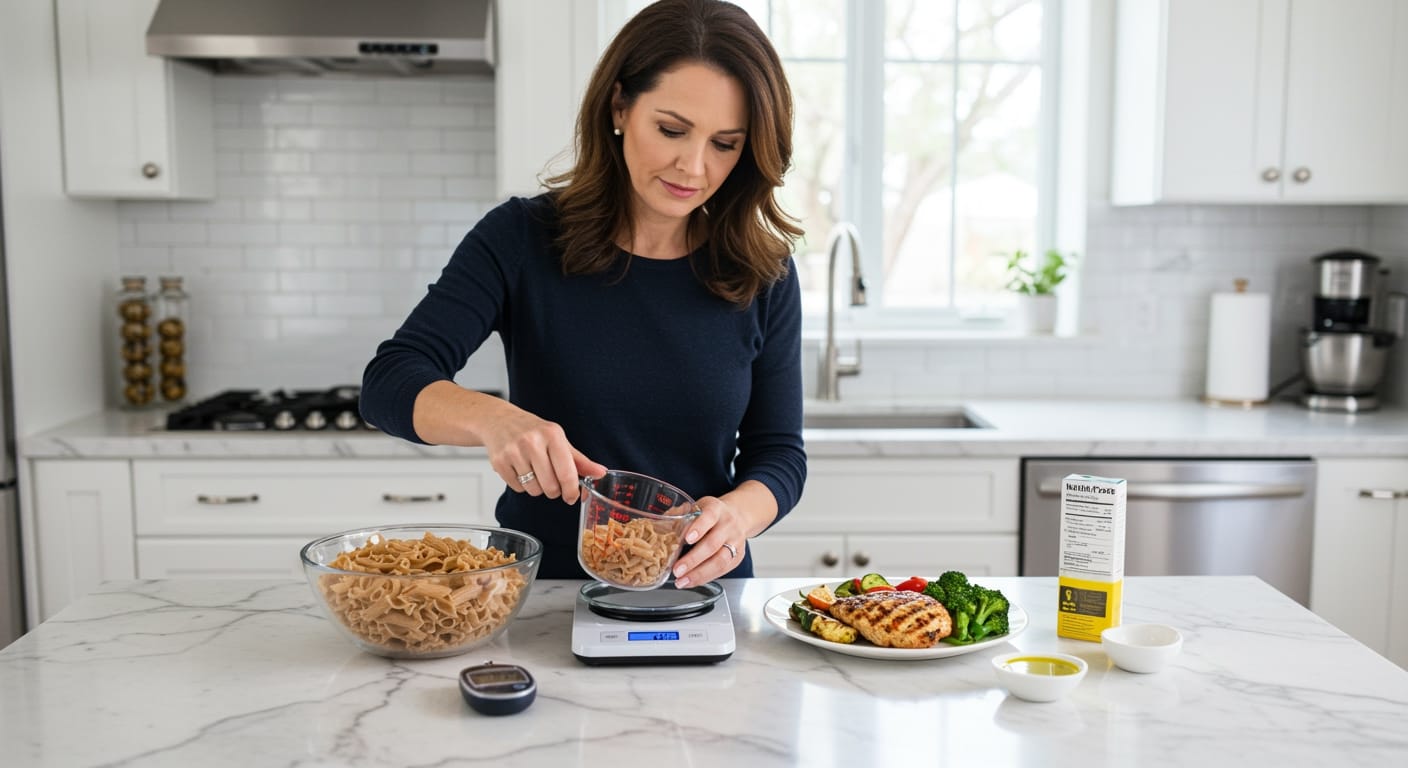✪ Key Takeaway: Diabetics can eat pasta without blood sugar spikes by choosing whole grain varieties, controlling portions, and pairing with protein and fiber.
Introduction
You stare at that box of pasta in your pantry and wonder if one bite will send your blood sugar through the roof.
Many diabetics believe pasta is completely off-limits because they fear dangerous blood sugar spikes that could harm their health.
Hi, I’m Abdur, your nutrition coach and today I’m going to explain exactly how diabetics can enjoy pasta safely without compromising their blood sugar control.
Does pasta type really matter for blood sugar?
The type of pasta you choose makes a massive difference in how your blood sugar responds after eating.
Regular white pasta has a glycemic index of 50-55, which means it raises blood sugar moderately fast.
Whole wheat pasta scores lower at 42-45 on the glycemic index because the fiber content slows down sugar absorption.
Legume-based pastas made from lentils, chickpeas, or black beans have even lower glycemic values around 35-40.
These alternative pastas also pack more protein and fiber per serving compared to traditional wheat varieties.
The extra protein helps stabilize blood sugar by slowing carbohydrate digestion and absorption in your small intestine.
✪ Pro Tip: Choose pasta made from legumes or whole grains to cut your glycemic response by up to 30 percent.
How much pasta can diabetics safely eat?
Portion control becomes your most powerful tool for managing blood sugar when eating pasta.
A safe serving size for most diabetics is one-third cup of cooked pasta, which contains about 15 grams of carbohydrates.
This amount fits perfectly into a diabetic meal plan without causing dangerous blood sugar spikes.
Many people eat 2-3 times this amount without realizing they are consuming 45-60 grams of carbs in one sitting.
Use a measuring cup or kitchen scale to ensure accurate portions until you can eyeball the right amount.
Remember that restaurant portions are typically 3-4 times larger than recommended serving sizes for diabetics.
You can increase your pasta portion slightly if you pair it with adequate protein and vegetables to balance the meal.
✪ Fact: Restaurant pasta servings contain an average of 3-4 cups, delivering 180-240 grams of carbohydrates per plate.
What should you eat with pasta to control blood sugar?
The foods you pair with pasta can dramatically reduce its impact on your blood sugar levels.
Adding lean protein like grilled chicken, fish, or tofu helps slow carbohydrate absorption and prevents rapid glucose spikes.
Non-starchy vegetables such as broccoli, spinach, bell peppers, and zucchini provide fiber that further slows digestion.
Healthy fats from olive oil, avocado, or nuts also help moderate the glycemic response of your pasta meal.
A balanced diabetic pasta meal should contain 50 percent vegetables, 25 percent protein, and 25 percent pasta.
This combination ensures you get adequate nutrition while keeping blood sugar stable throughout the meal.
Avoid pairing pasta with sugary sauces, garlic bread, or other high-carb sides that will compound the glycemic load.
✪ Note: Adding 4 ounces of protein to your pasta can reduce blood sugar spikes by up to 40 percent.
When is the best time to eat pasta as a diabetic?
Timing your pasta consumption can make the difference between stable blood sugar and dangerous spikes.
Eating pasta during lunch or early dinner allows your body more time to process the carbohydrates before bedtime.
Your insulin sensitivity is typically higher during daytime hours, making it easier to manage pasta-induced blood sugar rises.
Avoid eating pasta late at night because your metabolism slows down and glucose clearance becomes less efficient.
If you exercise regularly, consider eating pasta 2-3 hours before your workout to use the glucose for energy.
Post-workout pasta consumption can also be beneficial because your muscles readily absorb glucose for recovery.
Monitor your blood sugar 2 hours after eating pasta to understand how your body responds and adjust timing accordingly.
✪ Pro Tip: Eat pasta between 12-6 PM when your insulin sensitivity peaks for optimal blood sugar control.
How should you prepare pasta to minimize blood sugar impact?
The way you cook pasta affects its glycemic index and subsequent blood sugar response.
Cooking pasta al dente (firm to the bite) results in a lower glycemic index compared to overcooked, mushy pasta.
Al dente pasta requires more energy to digest, which slows glucose absorption and prevents rapid blood sugar spikes.
Cooling cooked pasta and reheating it creates resistant starch, which has an even lower impact on blood glucose.
This resistant starch acts more like fiber in your digestive system, feeding beneficial gut bacteria instead of spiking blood sugar.
Adding a tablespoon of vinegar or lemon juice to your pasta sauce can also help reduce the glycemic response.
These acidic ingredients slow gastric emptying and carbohydrate absorption, leading to more stable blood sugar levels.
✪ Fact: Reheated pasta contains 50 percent more resistant starch than freshly cooked pasta, significantly lowering its glycemic impact.
The Bottom Line
Diabetics can absolutely enjoy pasta without dangerous blood sugar spikes by making smart choices about type, portion, timing, and preparation methods.
The key to diabetic success is not elimination, but education and moderation.
I would love to hear about your experiences with pasta and blood sugar management, so please share your questions, tips, or concerns in the comments below.
References
At NutritionCrown, we use quality and credible sources to ensure our content is accurate and trustworthy. Below are the sources referenced in creating this article:
- January AI: Glycemic Index of Pasta
- Glycemic Index Net: Pasta Glycemic Index Values
- PMC: Carbohydrates and Glycemic Response
- Diabetes Canada: The Glycemic Index and You
- Better Health Victoria: Carbohydrates and the Glycaemic Index





